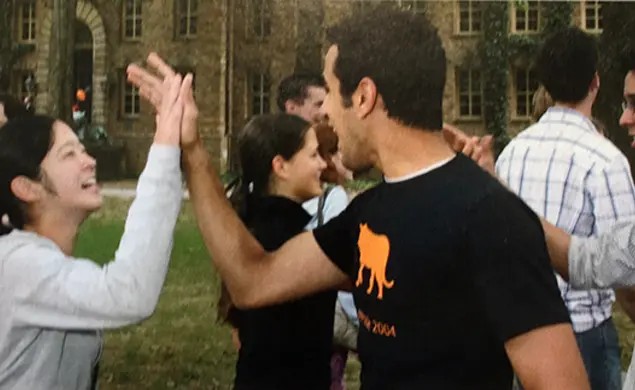Timeline: Opening Exercises
 oe_2004.png
oe_2004.pngPAW looks back at coverage of Opening Exercises, from Woodrow Wilson 1879’s first year as University president to the inaugural Pre-rade.
1902
At Opening Exercises in Marquand Chapel, the University gathered to greet its new president, Woodrow Wilson 1879, “and this usually perfunctory exercise took on quite an air of an academic stunt, including an academic procession, the faculty, with a sprinkling of trustees having hurriedly taken their gowns and hoods out of the summer moth-bags for the occasion.” Wilson opened with a prayer, assuaging concerns from PAW readers that as a non-clergyman, he might “revolutionize Princeton’s traditional attitude toward religion.”
1915
Faculty processed in caps and gowns while students hurried to Marquand Chapel on bicycles in 1915. The traditional opening would not look quite the same in coming years: In 1916, it was delayed by a quarantine following a polio outbreak; in 1917, it proceeded normally but with a 57 percent decrease in the freshman class due to World War I; and by 1918, the audience included scores of men brought to campus for military training.
1928
Opening Exercises moved to the recently completed University Chapel, where President John Grier Hibben 1882 told students that the were, in a sense, parasites, “drawing that which enriches our life from the labors and thought of other.” Through education, he added, “we may become something more than an interested hanger-on in the march of the world’s progress.”
1941
Three months before Pearl Harbor, President Harold Dodds *1914’s address included strong words about American involvement in World War II: “It is my firm conviction that the United States should abandon the policy of drift and the psychology of passive defense which has characterized us for the past two years and without qualification of mental reservation marshal the full strength of our national power against a totalitarian axis.”
A year later, PAW reported that nearly 3,000 alumni were on active duty.
1969
Opening Exercises drew a mere passing mention, but PAW devoted several pages to the story of the year: the beginning of coeducation. September issues included interviews with seven of “the multifarious freshwomen” and a profile of Halcyone Bohen, the first woman assistant dean. In October, transfer student Mary Azoy ’71 published a four-page essay on her impressions of coeducation. “Of course it’s not heaven here,” she wrote. “Who ever said that it would be?”
1981
Mike Kennedy ’52, a former Foreign Service officer who had been held hostage in Iran, spoke to during the freshman week Honor Committee assembly. Kennedy recalled one night when the hostages were stripped down and held against a wall, with guns poked in their necks. Afterward, he said, he realized “as I never had before that my integrity was the most important thing to me ever and always.”
2001
“Learning and discovery are intended to spill out of the classroom, laboratory and library and invade every nook and cranny of the university,” President Shirley Tilghman told students at her first Opening Exercises. “It has always fascinated me that the process of scholarship can be both a highly solitary activity and a distinctly social one.” Two days later, the campus community grieved together after the Sept. 11 terrorist attacks.
2004
Members of the Class of 2008 celebrated their status after Opening Exercises by parading through FitzRandolph Gate onto Nassau Hall’s front lawn. Freshmen streamed up the walk, passing members of the Classes of 2005, 2006, and 2007 and occasionally exchanging high-fives with them. The “Pre-rade” tradition has since grown to include alumni among the cheering greeters.
The Latest
See all





